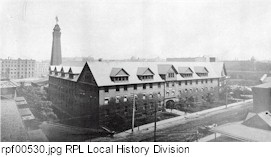
The Kimball Tobacco Company Factory
Established in 1846 by William S. Kimball and James C. Hart, the original Kimball Tobacco Factory stood on St. Paul and Court Streets for more than 30 years before relocating to the well known and highly recognizable facility on Court Street along the Erie Canal in 1880. The major contributing factor to this highly successful industry was William Kimball’s very direct involvement in nearly all aspects of the manufacturing process. Hiring only the best cutters, inventing and patenting many devices to aid in the speedy and uniform production of cigarettes, as well as demanding the best packaging and advertising for his product, Kimball’s success afforded him the ability to build this new facility from the ground up, creating a new and dynamic addition to the Rochester skyline.
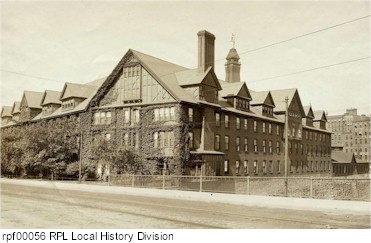 |
|
This new factory, designed by James G. Cutler, extended 218 feet on Court Street and almost 500 feet from Court Street to the aqueduct. It stood four stories tall, with a slate roof and timbered gables and dormers. The 150-foot smokestack was topped with the foghorn from the original factory.
The truly distinguishing feature of the Kimball Tobacco Factory, though, came a year after it opened. In 1881 William Kimball commissioned his brother-in-law, J. Guernsey Mitchell, to create a replica of Mercury, the symbol of commerce. Mercury was made of riveted bronze plates, assembled by the John Siddons’ Architectural Galvanized Iron Works, and stood 21 feet tall on top of the smokestack.
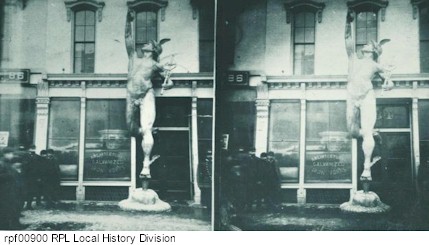 |
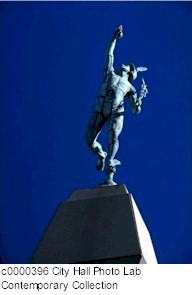 |
Mercury quickly became a characteristic and beloved feature of the downtown Rochester skyline and outlasted the lifetime of the building that it originally adorned.
The Kimball Tobacco Company remained in operation until 1905, a full ten years after the death of Mr. William Kimball. When the tobacco company shut down, Cluett Peabody and Company took over the building, manufacturing shirts and collars. In 1924, George Eastman acquired the property and leased to the City of Rochester to be used as the City Hall Annex. The building also served as a branch of the Rochester Public Library.
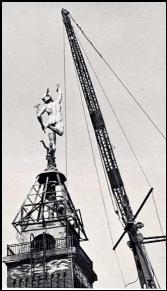 Unfortunately, the building was
demolished in 1951 to make way for the Community War Memorial, currently known as the Blue
Cross Blue Shield Arena.
Unfortunately, the building was
demolished in 1951 to make way for the Community War Memorial, currently known as the Blue
Cross Blue Shield Arena.
Mercury, though, was spared. The statue was carefully removed from its perch and put into storage.
For the next twenty-three years Mercury remained in a warehouse in Charlotte before being reborn on top of the Lawyers Cooperative Extension building, where it still stands today.
|
|
| Images of Mercury published by the Lawyer's Cooperative Publishing Company. The image on the right was an architect's rendering of the statue on the Lawyer's Co-op before Mercury was actually placed on top of the building. | |
Send comments to Webmaster
Copyright 2021 Monroe County (NY) Library System
115 South Ave., Rochester, NY 14604